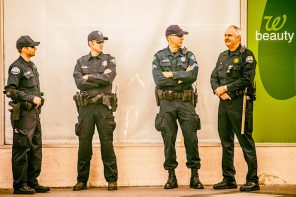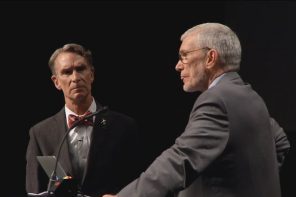Three days after police officer Michael Slager shot and killed Walter Scott in North Charleston, South Carolina earlier this month a video surfaced that led to the officer’s arrest for murder. Passerby Feiden Santana had recorded Scott fleeing as Slager repeatedly shot him in the back, belying the officer’s claims that Scott posed an imminent threat at the time.
During the Scott family’s press conference to address the widely-circulated video, attorney Chris Stewart stressed the rarity and importance of the footage, while Scott’s mother, evoking the call and response tradition, followed each of Stewart’s statements with a pained, “Thank you Lord” or “Glory, hallelujah.”
Judy Scott’s reaction suggests that it took divine intervention to produce definitive evidence that her son, a black man, was indeed murdered by a white police officer. The media was equally mesmerized. NPR’s Tom Ashbrook called the video “a miracle,” while Fox’s Greg Gutfeld characterized it as irrefutable proof of deliberate homicide, gushing that, “Cameras, unlike people, are unbiased. And this is the answer.”
The video is transcendent, above human interpretation or intervention. The city of North Charleston agreed, ordering 250 body cameras for the city’s entire department.
But miracles can be too good to be true. Body cameras offer a deceptively enticing solution to police brutality, but treating cameras as a panacea minimizes the importance of who holds the camera and who mediates its footage. Even photography can’t make us entirely objective.
Race Through the Aperture
When his “The Five” co-host Dana Perino asked what he thought about the situation in North Charleston, Greg Gutfeld insisted that the camera distilled the encounter between Slager and Scott down to its essence: one man shooting another man in the back. “The camera sees more than color,” he maintained, concluding ultimately that, “you can’t theorize; you can’t come up with hypotheticals.”
Yet racially charged theories and hypotheticals appeared almost immediately upon the video’s release. Faced with the horrific footage of one man shooting another in the back, viewers began to speculate, not about the man who had fired the gun, but about the man who had been killed.
A black man running from a white police officer could not have been entirely innocent, the thinking ran. As Free Republic commenter “9th Life” put it, “Boy scouts don’t run away from the cops.” Media outlets across the political spectrum soon highlighted the fact that Walter Scott owed approximately $18,000 in child support payments. The blameless victim of police brutality became a prevailing stereotype of African-American fathers: the deadbeat dad.
While no one suggested that unpaid child support could justify Scott’s murder, his debt proved that he was no “boy scout,” diminishing the impact of his murder. This familiar response—the suggestion that black victims are less worthy of mourning when they don’t live up to the standards of middle-class respectability—reveals that even when a video clearly shows a black man being shot in the back by a white police officer, the footage is never objective. Images are interpreted through our filters, which often include race and class prejudice.
Who Holds the Camera?
One of the earliest and most controversial activities of the Black Panther Party was the police patrol. Panthers would follow police cruisers and observe officers as they conducted traffic stops and carried out arrests. BPP co-founder Huey Newton in particular was known for his ability to cite entire sections of the California legal code from memory, educating African Americans about their rights as they were arrested. The underlying principle of Panther patrols was that the members of black communities should be able to actively supervise the police in their own neighborhoods.
Feiden Santana’s decision to record and release the video of Walter Scott’s murder recalls the spirit of such patrols, and would seem to warrant measures to bolster protection for those who witness and report police brutality. While North Charleston’s new mandate that each of its police officers wear their own body cameras may be a step in the right direction, there is reason to remain skeptical.
Mayor Keith Summey concluded that the “lesson” from the release of Santana’s video is that the public should “give us the appropriate time to investigate, find out exactly what happened, and… act accordingly.” In other words, the North Charleston Police Department can be trusted to act in the face of clear-cut, objective evidence, and body cameras will ensure that officials will have access to such evidence in the future.
Unlike Santana’s video recording—an act of guerilla oversight of police activity—body cameras bring footage within the institution of police power. In the hands of police, body cameras can be switched off and their footage destroyed or they can be used to embarrass and exploit those who are subject to police harassment and abuse. They have the potential to cause more harm to the very people they are purported to protect.
Mandating body cameras for police officers is an understandable response to the murder of Walter Scott—many family survivors of police shootings believe body cameras might have prevented Scott’s death—but their neutrality is far from given. The “miraculous” objectivity of video footage is inherently limited by who holds the camera and who interprets its footage.




